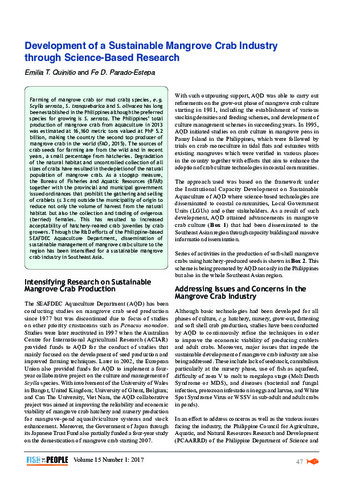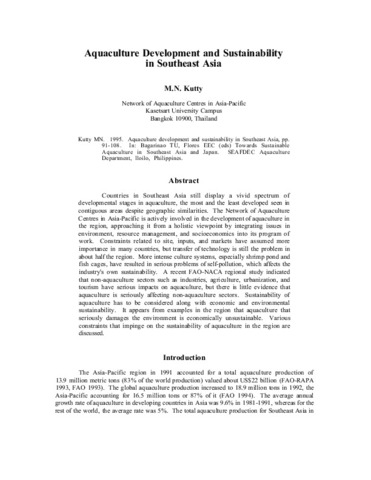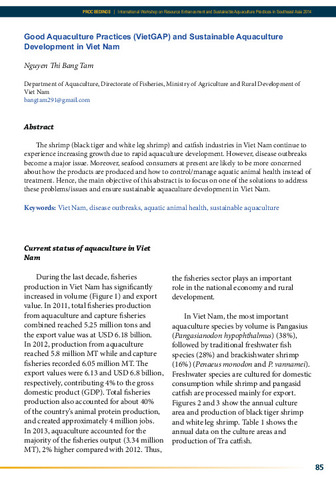Development of a sustainable mangrove crab industry through science-based research
- Global styles
- MLA
- Vancouver
- Elsevier - Harvard
- APA
- Help

View/Open
Date
2017Page views
266ASFA keyword
aquaculture development 
aquaculture economics
aquaculture regulations
brackishwater aquaculture
commercial species
crab culture
culture effects
cultured organisms
environmental degradation
fishery regulations
marine crustaceans
resource management
seed production
sustainable aquaculture
sustainability

aquaculture economics

aquaculture regulations

brackishwater aquaculture

commercial species

crab culture

culture effects
cultured organisms
environmental degradation

fishery regulations

marine crustaceans

resource management

seed production

sustainable aquaculture

sustainability

AGROVOC keyword
Metadata
Perlihat publikasi penuhShare
Abstract
Farming of mangrove crab (or mud crab) species, e.g. Scylla serrata, S. tranquebarica and S. olivacea has long been established in the Philippines although the preferred species for growing is S. serrata. The Philippines’ total production of mangrove crab from aquaculture in 2013 was estimated at 16,160 metric tons valued at PhP 5.2 billion, making the country the second top producer of mangrove crab in the world (FAO, 2015). The sources of crab seeds for farming are from the wild and in recent years, a small percentage from hatcheries. Degradation of the natural habitat and uncontrolled collection of all sizes of crabs have resulted in the depletion of the natural population of mangrove crab. As a stopgap measure, the Bureau of Fisheries and Aquatic Resources (BFAR) together with the provincial and municipal government issued ordinances that prohibit the gathering and selling of crablets (≤3 cm) outside the municipality of origin to reduce not only the volume of harvest from the natural habitat but also the collection and trading of ovigerous (berried) females. This has resulted to increased acceptability of hatchery-reared crab juveniles by crab growers. Through the R&D efforts of the Philippine-based SEAFDEC Aquaculture Department, dissemination of sustainable management of mangrove crab culture to the region has been intensified for a sustainable mangrove crab industry in Southeast Asia.
Suggested Citation
Quinitio, E. T., & Parado-Estepa, F. D. (2017). Development of a sustainable mangrove crab industry through science-based research. Fish for the People , 15(1), 47-51. http://hdl.handle.net/20.500.12066/1008
Type
magazineArticleISSN
1685-6546Koleksi
- Fish for the People [41]
Related items
Showing items related by title, author, creator and subject.
-
Aquaculture development and sustainability in Southeast Asia
Kutty, M. N. (Aquaculture Department, Southeast Asian Fisheries Development Center, 1995)Countries in Southeast Asia still display a vivid spectrum of developmental stages in aquaculture, the most and the least developed seen in contiguous areas despite geographic similarities. The Network of Aquaculture Centres ... -
Good aquaculture practices (VietGAP) and sustainable aquaculture development in Viet Nam
Nguyen, Thi Bang Tam (Aquaculture Department, Southeast Asian Fisheries Development Center, 2015)The shrimp (black tiger and white leg shrimp) and catfish industries in Viet Nam continue to experience increasing growth due to rapid aquaculture development. However, disease outbreaks become a major issue. Moreover, ... -
The Philippine aquaculture industry
Camacho, Arsenio S.; Macalincag-Lagua, Natividad (Aquaculture Department, Southeast Asian Fisheries Development Center, 1988)The aquaculture sector of the Philippine fishing industry registered the highest growth rate of 12.5% in 1977-1986. The contribution of aquaculture to the total fish production was equivalent to 24% in 1986 compared to ...




